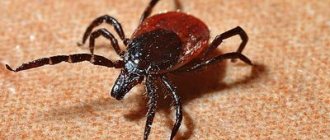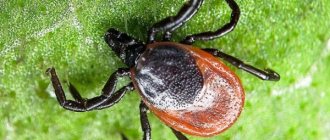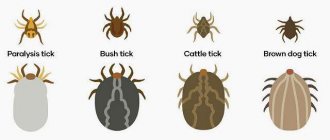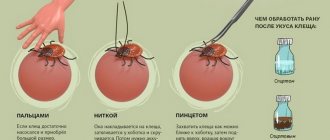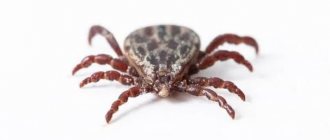Valentin Vlasov, Vera Rar, Sergey Tkachev, Nina Tikunova “Science at First Hand” No. 5/6(85), 2019
The composition uses a photo of a female ixodid tick, Amblyomma cajennense,
, carrier of Rocky Mountain spotted fever pathogens
Every year, hundreds of thousands of people visit medical institutions due to a tick bite. For these blood-sucking parasites, humans are only incidental “prey,” but ticks serve as carriers of a whole arsenal of pathogens that cause diseases in humans and animals. Anyone who spends time in nature, including our pets, can face the problem of tick-borne infections; Farm animals also suffer from tick-borne infections. The purpose of this article is to better acquaint readers with the habits and lifestyle of ixodid ticks, primarily common in our country, which can carry about three dozen diseases, including tick-borne encephalitis and borreliosis. In recent years, the problem of tick-borne infections has been aggravated by the fact that the range of these ticks both in Russia and in other countries of the world is rapidly expanding.
About the authors
| Valentin Viktorovich Vlasov — Academician of the Russian Academy of Sciences, Doctor of Chemical Sciences, Professor, Director of the Institute of Chemical Biology and Fundamental Medicine of the SB RAS. Laureate of the State Prize of the Russian Federation (1999). Author and co-author of more than 200 scientific papers and nine patents. |
| Vera Alexandrovna Rar — Candidate of Biological Sciences, researcher at the Laboratory of Molecular Microbiology at the Institute of Chemical Biology and Fundamental Medicine of the Siberian Branch of the Russian Academy of Sciences (Novosibirsk). Author and co-author of 76 scientific papers. |
| Sergey Evgenievich Tkachev — Candidate of Biological Sciences, researcher at the Laboratory of Molecular Microbiology at the Institute of Chemical Biology and Fundamental Medicine of the Siberian Branch of the Russian Academy of Sciences (Novosibirsk). Author and co-author of 97 scientific papers. |
| Nina Viktorovna Tikunova — Doctor of Biological Sciences, Head of the Laboratory of Molecular Microbiology, Institute of Chemical Biology and Physics of the Siberian Branch of the Russian Academy of Sciences (Novosibirsk). Graduate of NSU (1984). |
Ixodid ticks are found in all parts of the world, including islands and coasts of the Arctic and Antarctic, and in various climatic zones - from taiga to desert (Balashov, 1998). Among them there are both fairly “omnivorous” and highly specialized species that feed only on birds, chiropterans or small mammals (Estrada-Pena et al., 2017).
The main harm from ticks to host animals is associated with the direct parasitism of a large number of ticks on individuals, which can lead to high blood loss or severe intoxication as a result of parasite saliva entering the body. There are known cases of death of wild animals due to massive parasitism of ixodid ticks: wild antelope in the Zimbabwe National Park, young white-tailed deer in the USA, moose in Canada and the northern USA.
The incidence of ticks in farm animals can also be very high in the absence of special anti-tick treatment. Thus, one individual of cattle can simultaneously feed on several dozen, and several hundred ticks per season; the total blood loss is calculated in liters! Even cases of death of sheep as a result of several hundred ticks parasitizing them have been described (Balashov, 1998).
As for humans and their pets, such as dogs, the main danger of ticks for them is the high risk of infection in the event of even a single bite. Ixodid ticks carry pathogens of viral, bacterial and protozoal infections that can infect people. It is impossible to eradicate such diseases, since their foci exist in nature regardless of humans, and the vectors themselves are an integral part of natural ecosystems. And to protect yourself from ticks, you need to know the behavior and ecology of our potential “enemy”.
Ticks are often mistakenly called insects, but it is easy to distinguish a potential bloodsucker from a harmless bug: adult ticks have eight legs, like spiders, and not six, like insects.
Together with spiders, mites form the class of arachnids (Arachnida), which, along with crustaceans, insects and centipedes, is included in the phylum of arthropods (Arthropoda). Today, more than 50 thousand different types of ticks are known, and all of them are parasites, although not all pose a danger to humans or domestic animals. The tick family Ixodidae includes six main genera: Ixodes(249 species),
Haemaphysalis
(166),
Amblyomma
(142),
Rhipicephalus
(79),
Dermacentor
(36),
Hyalomma
(25 species).
The Latin name of each tick consists of two parts: an indication of the genus and species, and well-studied species also have a Russian name. For example, taiga tick ( Ixodes persulcatus
), meadow tick (
Dermacentor reticulatus
).Taiga tick Ixodes persulcatus
- the most common tick in Russia: its range extends from the northwestern regions (Leningrad region, Karelia) through the entire country to the Far East.
Inhabits taiga, forest and forest-steppe biotopes; found in the foothill forest-steppe and mountain forest belt up to an altitude of 2000 m (Filippova, 1977). Adults are active from early spring to mid-summer, larvae and nymphs are active throughout the warm season. Ixodes persulcatus
is the most dangerous for people, as it carries pathogens of the most severe forms of tick-borne encephalitis.
This species of tick is also a carrier of tick-borne borreliosis and relapsing fever ( Borrelia miyamotoi
) (Korenberg, 2013).
Infection can occur as a result of suction not only from females, but also from males who suction for a short time, and, in rare cases, nymphs. Male ( left
) and female (
right
) taiga tick
Ixodes persulcatus
. Photo by V. Panov (IS&EZh RAS, Novosibirsk) and S. TkachevIxodid ticks are the largest of all ticks: adults reach 2–13 mm in length. The most common taiga tick in Russia, I. persulcatus
The body length of a hungry female is 3–4 mm, a male is 2–3 mm, a nymph is 1.2–1.7 mm and a larva is less than 1 mm. The size of engorged ticks is significantly larger
Meet the Ixodid tick
Many ixodid ticks have only light-sensitive cells instead of eyes, so they use other senses to “hunt.”
Almost all ticks, with the exception of those belonging to the genera Ixodes and Haemaphysalis, have a pair of eyes. The legs consist of 6 movably connected segments. At the end of the paw there are two claws, and the pad located between them acts as a suction cup. On the paws of the first pair of legs are the main sensory organs of ticks - Haller's organs. The tick is fixed on the host's body with the help of teeth on the legs and outgrowths at the base of the head, between which the animal's hair is clamped. The elongated oral parts on the head form a proboscis, from the base of which palps with chemoreceptor and mechanoreceptor hairs extend. On the underside of the proboscis there are parallel rows of teeth directed backwards. The “jaws” (chelicerae) consist of a long “trunk”, from which, like a case, movable “fingers” extend, with which the mites cut through the host’s skin. Up
— “head” of the taiga tick (ventral view) and outgrowths at its base. Scanning electron microscope. Photo by E. Mitrofanova (IVEP SB RAS, Barnaul)
At long distances the main role is played by the multifunctional Haller organ
, with the help of which ticks are able to perceive changes in the concentration of carbon dioxide, specific components of the smell of a potential host (hydrogen sulfide, ammonia) and its thermal radiation at a distance of up to 10 m. Having reached the “victim”, ticks determine the most suitable place for suction using sensitive sensilla, consisting of cuticular hair and receptor cells, which are especially numerous on the paws and mouthparts.
The body of the ixodid tick consists of two sections: an unsegmented body, bearing legs (6 in larvae, 8 in nymphs and adult males and females), and a head. On the dorsal side there is a hard shield, which in females, nymphs and larvae covers only the anterior third or half of the body. The remaining part is covered with an extensible cuticle, which in hungry individuals forms a system of parallel microfolds that straighten during feeding.
The paired salivary glands of the tick secrete a secret containing many biologically active components that act as an analgesic, prevent blood clotting, suppress the host's immune responses, stimulate the release of histamine by the host's cells, etc. They can also secrete components of the cement sheath involved in fixing the tick on the body owner.
Well-fed and hungry female forest tick Ixodes ricinus
. © CC BY-SA 2.5, photo by Richard Bartz; © CC BY-SA 3.0, photo NOBBI
Another unique function of the salivary glands is osmoregulation. When there is a threat of drying out, hygroscopic saliva is secreted into the pre-oral cavity of the tick, which adsorbs water molecules from the air, which allows the tick to retain the necessary moisture in the body and remain viable for many months between blood meals. And, on the contrary, when feeding on blood, the tick is able to return about 70% of the “excess” absorbed water and salts by salivating at the bite site. As a result, the volume of saliva secreted by the tick during the entire feeding period significantly exceeds the body weight of the engorged tick (Biology of Ticks, 2014).
An Ixodid tick that has fed on the blood of its host animal. © CC BY 2.0 Michael Coghlan
Most ixodid ticks are characterized by the grazing-lurking type.
parasitism: hungry individuals climb onto vegetation, where they lie in wait for potential hosts passing by. Having received the necessary signals, the tick goes into a state of “active lurking,” making oscillatory movements with the first pair of legs extended forward until direct contact with the host animal.
For many ticks of the genus Ixodes
The nest-burrow type
is characteristic , when hungry individuals at all stages of development attack potential hosts in burrows and nests;
some have a mixed type of parasitism. There are also ticks adapted to living in houses, for example, the dog tick Rhipicephalus sanguineus
(Balashov, 1998; Yakimenko, 2013; Biology of Ticks, 2014).
About 60 species of ticks from the family Ixodidae have been found on the territory of Russia, but the most dangerous are ticks of the genus Ixodes
, the main carriers of the tick-borne encephalitis virus, the causative agents of ixodid tick-borne borreliosis (Lyme disease) and borrelia from the group of relapsing fevers.
Ticks of the genera Dermacentor
,
Haemaphysalis
and
Rhipicephalus
are the main carriers of pathogenic species of rickettsia, and
Hyalomma
- the Congo-Crimean hemorrhagic fever virus (Filippova, 1977, 1997).Ticks of the genus Hyalomma belong to the desert species. H. marginatum
(
left
) lives in the south of European Russia.
Larvae and nymphs feed on birds and rodents, while adults feed on ungulates. H. marginatum
is the main carrier of the Crimean-Congo hemorrhagic fever virus, a dangerous disease with a mortality rate of 16%.
The steppe tick Dermacentor marginatus
(
right
) lives in steppe and forest-steppe biotopes in southern Europe, European Russia and Western Siberia to the Krasnoyarsk Territory in the east. Serves as a carrier of pathogens of Siberian tick-borne typhus and Q fever. Photo by V. Yakimenko (Omsk Research Institute of Natural Focal Infections)
Nymph
Not all types of ticks go through all three stages in their development. Three instars are present in ixodid and argasid ticks. Sarcoptoid and teranichidae pass through the 1st and 3rd instars. Thrombidiform mites pass through the first two instars. Each age has its own name:
- protonymph;
- deutonymph;
- Tritonymph.
The protonymph already has 4 pairs of legs, which still have very few setae. Also at this stage, a genital opening and 2 genital setae with a pair of genital tentacles appear.
In deutonymphs, the number of setae on the tarsi increases. 6 genital setae and 4 genital tentacles appear.
Tritonymph continues to acquire genital tentacles (already 3 pairs) and setae. The number of tactile bristles on the legs and body surface increases. If you look at the images of all three forms, you can see that the anatomy of the third instar nymph is almost no different from the morphology of ticks.
Both the table and the house
Having clung to the host, ticks actively search for a suitable place to attach, preferably where it is more difficult for the host to get rid of them, for example, on the ears and head of rodents. On hedgehogs with their spines, mites are more evenly distributed, but on primates there are practically no mites. In regions with a dry and hot climate, ticks more often stick to the lower part of the body, protected from the sun. They can even be found in the mouths of elephants and in the nostrils of hippos and camels.
Ticks attach themselves to people in a variety of places: in the armpits, less often on the chest, abdomen, arms, buttocks and legs, as well as on the head, especially in children.
Ticks attach to the host's skin with their mouth parts, cut through it and use their proboscis to suck out blood, inflammatory infiltrate and tissue dissolution products, alternating this process with the introduction of saliva into the wound.
A sucked ixodid tick works like a well-oiled pump: per minute it makes from 2 to 60 acts of suction, strictly separated by acts of injecting saliva. Left
- an adult female ixodid tick feeding on a horse (after Estrada-Pena et al., 2017).
On the right
is the “head” of the taiga tick (view from the dorsal side). Scanning electron microscope. Photo by S. Tkachev (IBFM SB RAS, Novosibirsk)
Ixodid ticks feed slowly: larvae feed for 3–5 days, females for 5–15 days. During feeding, their body weight increases by one or two orders of magnitude: females of the largest species can absorb up to 8–10 ml of blood!
After finishing feeding, the larvae and nymphs fall away from the host and molt, moving to the next stage of development. In adult ticks, feeding is associated with reproduction. Partners, as a rule, meet on their host - hungry male and female ticks are not able to mate, with the exception of ticks of the genus Ixodes
. The male can remain on the host for several months and during this time fertilize several dozen females. The female mates only once, after which she quickly gains weight, falls away from the owner and after some time (from several days to months) lays eggs (from 800 to 20,000 depending on the species), after which she dies (Balashov, 1998; Biology of Ticks, 2014).
In most cases, the development of ixodid ticks occurs with a change of host at each stage of the life cycle. Their feeders are birds, reptiles and, first of all, mammals, especially rodents. Thus, the taiga tick parasitizes approximately 170 species of birds, 100 species of mammals and several species of reptiles. As a rule, small animals moving in the lower tiers are attacked by larvae and nymphs, and large animals are attacked by adult ticks (Balashov, 1998; Biology of Ticks, 2014).
The life cycle of ticks is complex. The eggs laid by the female hatch into larvae (still six-legged), which after molting turn into nymphs, and the nymphs into adults, called adults. The duration of the life cycle for different types of ixodid ticks can range from one to six or more seasons (years). At each stage of the cycle, the tick must once feed on blood, with the larva, nymph and adult feeding on different animal hosts. The larva drinks the blood of a small animal (rodent or bird). The nymph must find and attack a larger animal (squirrel, hedgehog, hare). The adult tick feeds on other, even larger animals, such as elk or deer. However, some species of ticks have adapted to carry out a full development cycle on one host animal, which is left only by the female who has drunk blood
Features of parasite hunting
It is worth noting some behavioral features of insects. It is noteworthy that only those individuals that have reached a certain degree of aggressiveness attack . This is, in particular, determined by the ambient humidity and temperature conditions. Also, the activity of the tick is affected by its internal water balance . If an insect has been sitting in ambush for a long time and has used up the necessary supply of fluid in the body, then it interrupts its hunt. To restore strength, it moves into the lower layers of vegetation, into the litter, where it is again saturated with life-giving moisture. After this, the insect continues its attack.
basically two hunting modes characteristic of ticks. The first is lying in wait tactics. The insect climbs onto the upper parts of the plants and takes a wait-and-see position. The second option is active pursuit. Yes Yes. They are capable of sniffing out and chasing their prey . Therefore, careless lying on the grass under the shade of a tree should be treated with caution. Insects sense their prey at a distance of 5-10 meters and can actively move in its direction. That is why the largest accumulation of parasites is observed where domestic animals are grazed or where there is a recreation area.
Expanding the boundaries
Over the past decades, the range of ixodid ticks has changed and expanded. Thus, if previously it was believed that in Russia the problem of tick-borne infections was relevant only for Siberia and the Far East, now it is well known to residents of the western regions of the country. Ticks are increasingly spreading in other regions of the planet: in the USA and Canada, China and the countries of Southeast Asia, South America.
Scientists believe that one of the reasons for this phenomenon is climate warming. It has been repeatedly shown that migratory birds can carry ticks over long distances (Sparagano et al., 2015). But if earlier ticks could not take root in the northern territories, now the situation has changed. In many regions of the planet, winters have become shorter and milder, and ticks are able to survive the winter more easily.
One star mite Amblyomma americanum
widespread in the southeastern United States.
This tick is known as a carrier of several species of Ehrlichia, the causative agent of tularemia and the recently discovered Heartland
and
Bourbon
. Thus, in Sweden and Norway for the period 1994–2008. The limit of occurrence of ticks has moved more than 200 km north along the Baltic coast (Jaenson et al., 2012). On the North American continent, ticks began to be found almost 1000 km further north compared to the period 1943–1983. And in the mountains in the north of the Czech Republic, where temperatures have risen by 1.4° over four decades, ticks appeared at altitudes of up to 1,300 m above sea level. In Russia in the 1960s. The taiga tick was found only in the southern regions of the Komi Republic, but now it is also found in the central ones: over the past forty years, the northern border of its range has moved 150–200 km (Loktev, 2015).
Extensive range of the meadow mite Dermacentor reticulatus
includes the territory of Europe, the European part of Russia and Western Siberia.
Often found in forested areas and on the outskirts of cities (in wastelands). It has two peaks of activity - spring and autumn. It poses the greatest danger to dogs, since it is a carrier of pathogens that cause a serious, life-threatening disease in them - canine piroplasmosis. In Eastern Siberia and the Far East, where D. reticulatus
is absent, cases of canine piroplasmosis have not been described. This photo was taken in the Moscow region. © CC BY-SA 4.0, photo by A. Yakovlev
The second possible reason for the change in the range of ticks is a change in the ecological situation caused by human activity. For example, naturalists who traveled to the USA in the mid-18th century noted a large number of ticks there. But a century later, due to the development of agriculture, the number of white-tailed deer, the main feeders of black-legged ticks,
, which led to a decrease in the number of these parasites. However, in the second half of the last century, the number of both host animals and ticks themselves increased manifold. Accordingly, the number of tick attacks on humans has increased as city dwellers began to spend more and more time in nature.
Western black-legged tick Ixodes pacificus
distributed on the western (Pacific) coast of the United States, where it serves as the main carrier of tick-borne borreliosis (Lyme disease).
The photo
shows a view from the dorsal and ventral sides. © CC BY 2.0, photo by Don Loarie
Recently, in Western Siberia, the range of the Pavlovsky mite
, and the cause of this event remains unclear.
At the end of the last century, its habitat was only in the territory of Altai and other mountainous regions (Salair Ridge, Kuznetsk Alatau). Now it is found in most of the studied lowland areas of the Novosibirsk and Tomsk regions, while in some areas, mainly with high anthropogenic load, the Pavlovsky tick has almost completely replaced the taiga tick
(Livanova et al., 2011; Romanenko, 2011).
Perhaps this change in range is associated with long-term anti-tick treatments of the area around large cities, which were carried out in the 1960–1980s. When these places began to be repopulated by ticks, I. pavlovskyi
received an advantage, since its life cycle is shorter, and it can feed on birds, the number of which in anthropogenic foci is higher compared to the number of large mammals, the main feeders of the taiga tick.
Tick Ixodes trianguliceps
parasitizes only on small mammals; it does not attach itself to people and large mammals.
At the same time, its range overlaps with the range of other ticks of the genus Ixodes, which attack people, and their feeders are the same species of animals. Therefore, I. trianguliceps
can infect people indirectly, through ticks of other species (Filippova, 1977; Yakimenko, 2013).
The photo
shows a well-fed female and nymph
of I. trianguliceps
on a vole. Photo by V. Yakimenko (Omsk Research Institute of Natural Focal Infections)
In some cases, the habitat of ticks is expanding southward. Thus, in Western Siberia in the 1960–1970s. range of the meadow tick
moved south, from the forest to the forest-steppe zone. The reason could be a combination of several factors: acaricidal treatment of forests and a change in the structure of rodent populations, the main hosts of the tick (Yakimenko, 2013).
Based on modeling of changes in climate and biotopes as a result of human activity, it was shown that in the 21st century. One can expect a reduction in the range of the taiga tick on the territory of states bordering Russia from the west, and by the end of the century this process will also take place in the European part of Russia (Yasyukevich, 2019). Presumably, in the Moscow region and the regions bordering it in the west and north-west, the taiga tick will disappear. A similar process will take place in areas to the south, where, due to climate warming, the forest will retreat, giving way to drier habitats.
At the same time, there are prerequisites for a significant expansion of the range of the taiga tick in the Kamchatka Territory and its appearance in the Magadan Region, and these forecasts are already beginning to come true. Thus, taiga ticks were recently discovered in the vicinity of Magadan (Dokuchaev, 2015). These ticks have been found on the Kamchatka Peninsula for quite a long time. At the same time, no larvae or nymphs were found there, which would be indirect evidence that the taiga tick can go through a full life cycle in this territory (according to the Federal Budgetary Institution of Health “Center for Hygiene and Epidemiology in the Kamchatka Territory” for 2022). Probably, the ticks are brought there by migratory birds.
Stages of the life cycle of ixodid ticks using the example of a widespread species - the European forest or dog tick Ixodes ricinus
. © CC BY-SA 3.0, photo by Alan R. Walker
Interspecies alliances
Pavlovsky's mite Ixodes pavlovskyi
was first discovered in the Russian Far East in the middle of the last century. The range consists of two separated parts - eastern and western, located in the Far East and Western Siberia. In morphology, genetic characteristics and activity it is similar to the taiga tick. It serves as a carrier of the same infectious agents as the taiga tick, although their occurrence in these two types of ticks differs significantly (Rar et al., 2017).The movement of the Pavlovsky tick population to the north coincided with another phenomenon—the discovery of its hybrids with the taiga tick. Interspecific hybridization is a fairly common phenomenon among closely related species of ixodid ticks. However, in the vast majority of cases, these interspecific hybrids are not capable of reproduction.
Thus, in Russia and Estonia, in places where the ranges of taiga and European forest ticks overlap, ticks with morphological and genetic characteristics of hybrids were found (Bugmyrin et al., 2015). However, the offspring obtained by laboratory crossing of these two species turned out to be infertile.
The entire range of the Pavlovsky tick is located within the distribution area of the taiga tick, and molecular genetic analysis revealed ticks with a hybrid genotype in all habitats of the Pavlovsky tick in the Tomsk and Novosibirsk regions and the Altai Republic. In some places, the relative abundance of hybrids exceeded 30%, and among them there were hybrids of both the first and second generations (Kovalev et al., 2015; Rar et al., 2019). All this suggests that these two types of ticks are capable of not only interbreeding, but also producing fertile offspring.
Why do spiders have webs?
The web that spiders weave is intended not only for building trapping networks, but also for:
- building cocoons for eggs. In this case, the web is used as a construction tool for the other side of life - its continuation. Actually, the construction of trapping nets by spiders is also a way to prolong life, because an individual dies when there is no food. But here we mean maintaining the integrity of the population. This function of the web has a much more global purpose;
- escape in case of danger. Here we are talking not so much about maintaining the integrity of the population as about preserving life. Thanks to the web, the spider can escape from something that poses a potential or obvious threat to it.
As you can see, the web is not only a means of attracting prey, but also a protective mechanism. An example is the use of a spider's web as a tool to build a cocoon. In this case, the spider web performs a protective function for the offspring of the arthropod. As you can see, a web is needed not just to get food.
